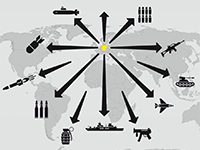Germany approves and exports weapons of war and military equipment to countries at war and in crisis, to states violating human rights and to regions of tension. It is precisely there that German arms exports contribute to fueling the arms dynamics and thus increase the risk that existing conflicts will escalate and be carried out violently.
Dr. Simone Wisotzki, Project Manager in the Research Department “International Security”, has been commissioned by Greenpeace to examine 30 years of German arms export policy and has documented numerous examples in which arms exports to third countries have been approved. Such cases should actually remain an exception, but with approval rates of around 60 percent in some years, they have become the norm. The most important buyers of German weaponry are the states of the MENA region, but also countries from South (East) Asia and South America. The general ban from 1971 on supplying weapons of war from Germany to non-NATO states has given way to a complicated set of rules consisting of laws, political principles and various procedures, which are supplemented by further regulations at the European and international level.
The study examines German arms export policy since 1990 and looks in particular at export licenses issues to third countries. In doing so, it is guided in its assessment by the eight criteria of the EU Common Position for the control of exports of military technology and equipment, which are similar to the German Political Principles for the export of weapons of war and other military equipment. The criteria are based on existing international humanitarian law, the United Nations Charter and human rights agreements. For example, the German government should assess the domestic situation in the final destination country with regard to tensions and armed conflicts or respect for human rights and international humanitarian law in the recipient country.
The study shows that Germany has repeatedly violated these criteria. It documents a large number of cases in countries where war has been waged with German weapons and serious human rights violations have been committed. In September 2014, for example, the police in Mexico violently attacked student protests with G36 assault rifles from German supplies and shot numerous students. Since 2015, a bloody proxy war has been raging in Yemen, in which the civilian population in particular suffers from wartime violence and hunger. The Yemen War Coalition, but especially Saudi Arabia, violates international humanitarian law with indiscriminate bombardments that also hit civilian targets, and with sea blockades. The weapons of war and other armaments used in this armed conflict also originate from Germany. Old stocks of the German Armed Forces and the former National People’s Army have also been handed over to third countries – for example, warships to Indonesia, with which soldiers were transported to Aceh in the civil war in 2003.
The examples in this study document how quickly arms exports and also equipment, including small arms and light weapons, enter the illegal cycle and the black market. The study also reveals a number of clear regulatory gaps in German arms export policy, such as the trend towards the internationalization of German arms companies. For example, joint ventures are being set up to supply conflict- and tension-prone countries and regions with German armaments technology. These and other regulatory gaps should be closed with a uniform and legally binding Arms Export Control Act which must then be legally enforced so that German arms exports do not end up in problematic third countries. Arms exports have a long half-life: The examples in the study show that the exports of the past have dramatic effects even many years later, when the political situation in the recipient country changes in such a way that the weapons supplied from Germany are used to wage war, suppress protest movements by force or violate human rights
